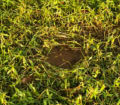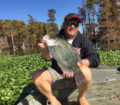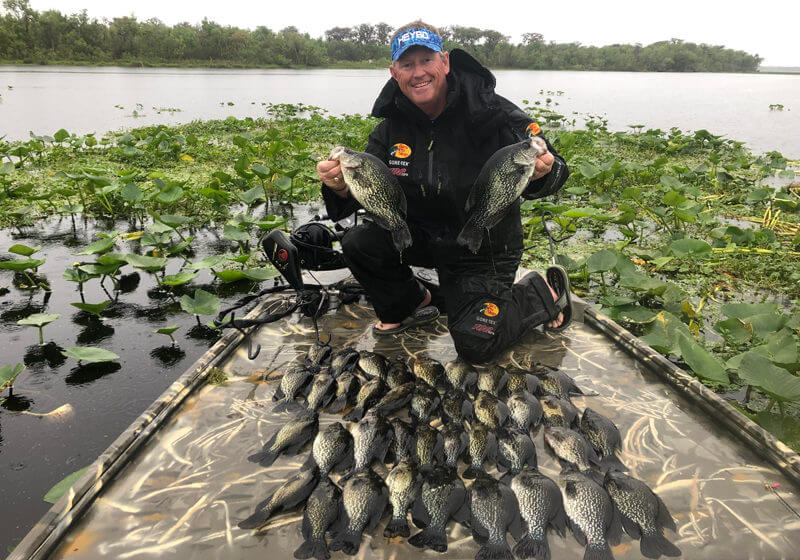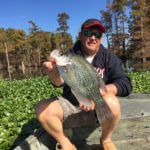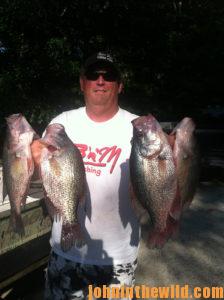 Editor’s Note: Whitey Outlaw from St. Matthews, South Carolina, has been fishing crappie tournaments for the last 40 years. He’s a third-generation crappie fisherman and consistently finishes in the top 15 in most of the tournaments he enters. Whitey’s home lake is Santee Cooper in South Carolina that was impounded from the Congaree River. Like most river systems, whether they’re dammed up or not, the Congaree was supported by a wide variety of creeks – often well away from the main river. Many of these creeks went through cypress and tupelo hardwood forests. So, when the river started backing up, these creeks were flooded and created what Outlaw calls, “The Swamp.” Many of these creeks became oxbow lakes that were cut off from the main river channel when the lake was impounded. The swamps that Outlaw fishes include Broadwater, McGirth’s Lake, Otter Flat and all the swamps attached to the main lake. However, most all rivers anywhere – whether they’re a part of a lake or a free-flowing stream – have creeks coming
Editor’s Note: Whitey Outlaw from St. Matthews, South Carolina, has been fishing crappie tournaments for the last 40 years. He’s a third-generation crappie fisherman and consistently finishes in the top 15 in most of the tournaments he enters. Whitey’s home lake is Santee Cooper in South Carolina that was impounded from the Congaree River. Like most river systems, whether they’re dammed up or not, the Congaree was supported by a wide variety of creeks – often well away from the main river. Many of these creeks went through cypress and tupelo hardwood forests. So, when the river started backing up, these creeks were flooded and created what Outlaw calls, “The Swamp.” Many of these creeks became oxbow lakes that were cut off from the main river channel when the lake was impounded. The swamps that Outlaw fishes include Broadwater, McGirth’s Lake, Otter Flat and all the swamps attached to the main lake. However, most all rivers anywhere – whether they’re a part of a lake or a free-flowing stream – have creeks coming 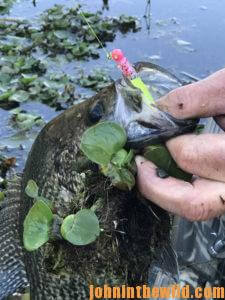 into them. Many of these creeks will have grass in them and often standing timber, just like they do at Santee Cooper in South Carolina.
into them. Many of these creeks will have grass in them and often standing timber, just like they do at Santee Cooper in South Carolina.
“If there’s plenty of crappie holding in the grass, you may not have to dig more than 15–20 holes to fish in during a day of fishing,” Whitey Outlaw says. “Sometimes you’ll catch 7–10 out of one hole, and other holes may only give-up one or two crappie. However, I have fished one hole before and caught as many as 70 crappie just as fast as I can get the jig out of a crappie’s mouth and put it back in the water. I’m often asked, ‘When you dig 15-20 holes in the grass, can you return the next day and fish those same holes?’ Most of the time if you’re fishing gator grass and hyacinths, the holes still will be where you’ve dug them. But even if you do have to reopen the holes, you’ll probably only have to move the grass just a little bit to get it back open or to make it bigger.”
Outlaw mentions that one big mistake people make when they’re fishing holes in the grass is, they’ll dig holes in front of their boats, and when they get ready to leave, they’ll drive right over the tops of the holes they’ve just dug.
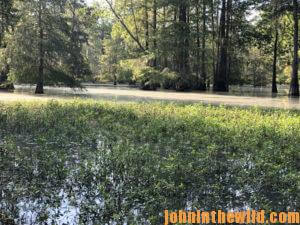 “I usually back out with my big motor and pull around to another section of the grass, then nose the front of my boat right to the front of the grass I want to fish, put the motor in gear, drive right up on top of the grass and then start digging my holes,” Outlaw reports. “I’ve learned if I’m catching fish out of one hole, I usually can catch crappie out of that same hole either the same day or the next week, if I don’t run over the top of that
“I usually back out with my big motor and pull around to another section of the grass, then nose the front of my boat right to the front of the grass I want to fish, put the motor in gear, drive right up on top of the grass and then start digging my holes,” Outlaw reports. “I’ve learned if I’m catching fish out of one hole, I usually can catch crappie out of that same hole either the same day or the next week, if I don’t run over the top of that 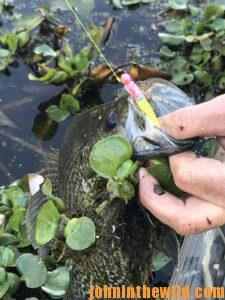 hole, and I don’t run through the grass, I always move my boat out to the edge of the grass, drive in grass-free water to the next place I want to fish, point the front of my boat right at the grass and use my big motor to slide the boat right on top of the grass.
hole, and I don’t run through the grass, I always move my boat out to the edge of the grass, drive in grass-free water to the next place I want to fish, point the front of my boat right at the grass and use my big motor to slide the boat right on top of the grass.
“To fish in the grass, I’m using my War Eagle (www.wareagleboats.com) aluminum boat. I do all I can to protect the integrity of the grass beds I’m fishing and not tear up the grass by running my big motor over their tops or by trying to back out of the grass when I put my boat in reverse. Instead I start to slowly back the boat up to move to another part of that grass bed or a new grass bed.
“Another question I’m often asked is, ‘Why doesn’t the prop wash from your big motor fill in the hole that you’ve created when you pull the boat up to the spot you’re going to fish?’ Most of the time, the grass will be really dense. I try to dig my holes 8–10 feet off the side of the boat, so that the heavy part of my prop wash 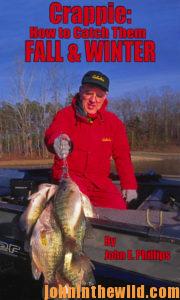 will push the grass back together and fill up the hole that I’ve created. When I slide up on the grass, my boat is just pushing the grass down, not destroying it. Once I back out of the grass, my boat just slides across the top of the grass, and the prop wash doesn’t destroy the grass. If you come back to that same hole in 2–3 hours, you usually won’t even be able to see where the boat has been sitting on top of the grass because the grass already has stood back up.”
will push the grass back together and fill up the hole that I’ve created. When I slide up on the grass, my boat is just pushing the grass down, not destroying it. Once I back out of the grass, my boat just slides across the top of the grass, and the prop wash doesn’t destroy the grass. If you come back to that same hole in 2–3 hours, you usually won’t even be able to see where the boat has been sitting on top of the grass because the grass already has stood back up.”
To learn more about crappie fishing, check out John E. Phillips’ book, “Crappie – How to Catch Them Fall and Winter,” available in Kindle and print versions at http://amzn.to/16AzIZi
Tomorrow: What Line and Pole Does Whitey Outlaw Fish with For Crappie

